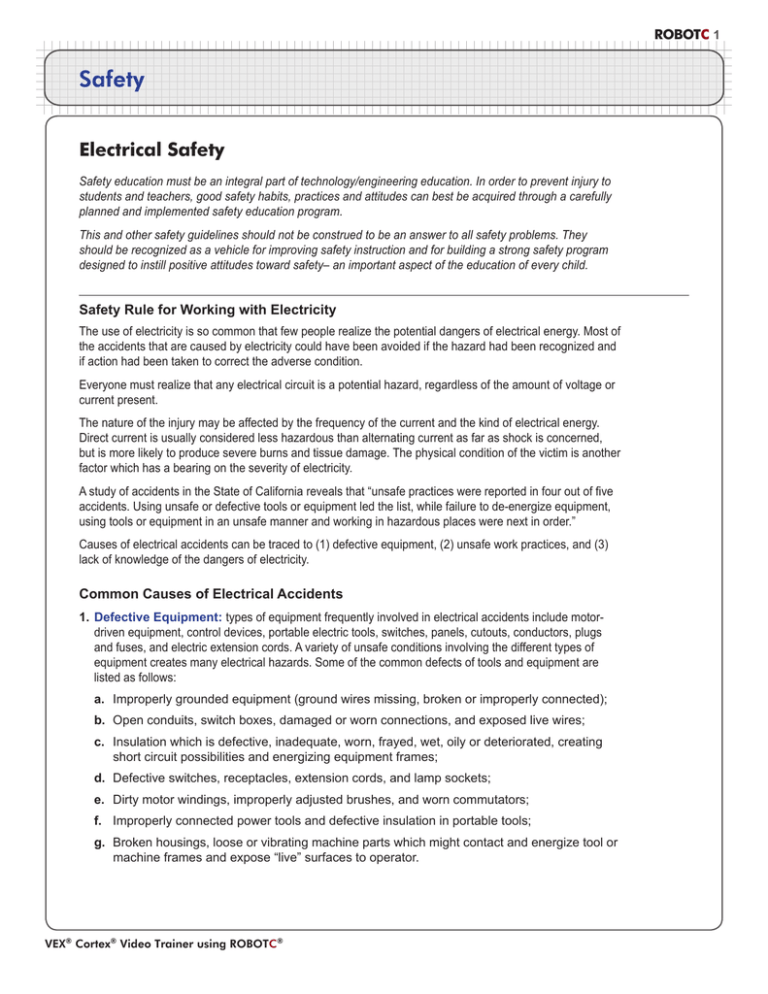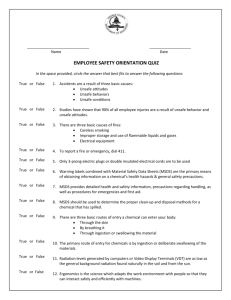Electrical Safety
advertisement

ROBOTC 1 Safety Electrical Safety Safety education must be an integral part of technology/engineering education. In order to prevent injury to students and teachers, good safety habits, practices and attitudes can best be acquired through a carefully planned and implemented safety education program. This and other safety guidelines should not be construed to be an answer to all safety problems. They should be recognized as a vehicle for improving safety instruction and for building a strong safety program designed to instill positive attitudes toward safety– an important aspect of the education of every child. Safety Rule for Working with Electricity The use of electricity is so common that few people realize the potential dangers of electrical energy. Most of the accidents that are caused by electricity could have been avoided if the hazard had been recognized and if action had been taken to correct the adverse condition. Everyone must realize that any electrical circuit is a potential hazard, regardless of the amount of voltage or current present. The nature of the injury may be affected by the frequency of the current and the kind of electrical energy. Direct current is usually considered less hazardous than alternating current as far as shock is concerned, but is more likely to produce severe burns and tissue damage. The physical condition of the victim is another factor which has a bearing on the severity of electricity. A study of accidents in the State of California reveals that “unsafe practices were reported in four out of five accidents. Using unsafe or defective tools or equipment led the list, while failure to de-energize equipment, using tools or equipment in an unsafe manner and working in hazardous places were next in order.” Causes of electrical accidents can be traced to (1) defective equipment, (2) unsafe work practices, and (3) lack of knowledge of the dangers of electricity. Common Causes of Electrical Accidents 1.Defective Equipment: types of equipment frequently involved in electrical accidents include motordriven equipment, control devices, portable electric tools, switches, panels, cutouts, conductors, plugs and fuses, and electric extension cords. A variety of unsafe conditions involving the different types of equipment creates many electrical hazards. Some of the common defects of tools and equipment are listed as follows: a. Improperly grounded equipment (ground wires missing, broken or improperly connected); b. Open conduits, switch boxes, damaged or worn connections, and exposed live wires; c. Insulation which is defective, inadequate, worn, frayed, wet, oily or deteriorated, creating short circuit possibilities and energizing equipment frames; d. Defective switches, receptacles, extension cords, and lamp sockets; e. Dirty motor windings, improperly adjusted brushes, and worn commutators; f. Improperly connected power tools and defective insulation in portable tools; g. Broken housings, loose or vibrating machine parts which might contact and energize tool or machine frames and expose “live” surfaces to operator. VEX® Cortex® Video Trainer using ROBOTC® ROBOTC 2 Safety 2.Unsafe Practices: Unsafe practices and work procedures result in electrical accidents and fires. Some of the common unsafe acts committed in the shop are: a. Using ungrounded equipment and portable tools (except double insulated tools) or removing ground connections; b. Using defective tools or equipment in need of repair; c. Using equipment which does not meet the approval of the Underwriters Laboratories for the intended use; d. Unsafe cleaning of electrical panels, switch boxes, motors, and other electrical equipment with water or dangerous solvents; e. Overloading of circuits or overfusing circuits by the use of wrong size or type of fuse; f. Failure to use explosion-proof or other special wiring methods in hazardous locations. g. Failure to positively lock out or otherwise de-energize and tag equipment or circuits to be worked on. Do not rely on gloves, rubber mats, etc., for electrical installation and repair. h. Installation or extension of electrical facilities in a manner not meeting the National Electrical Code; i. Repetitive closing of switches or circuit breakers when there is a fault on the circuit. j. Using light duty, ungrounded extension cords for industrial service; k. Failure to maintain clear access to electrical panels. Clearance of 30 inches is required by the Federal Code. l. Use of extension cords in place of permanent wiring extensions; m.Work practices which overload motors, insulation, wires or electrical accessories; n. Disconnecting of electric cords by pulling on the cords rather than on the plug; o. Use of metal ladders while working on electrical equipment; p. Failure to label switch panels and boxes. 3.Lack of knowledge: teaching a basic understanding of electrical safety is part of a Technology/ Engineering Educational Program. Ground Fault Protection – a recent development that can save lives. Devices are now readily available which give sure protection against electrocution or serious shock from defective portable tools or cords. Their use should be encouraged in all areas, but particularly where there is a serious shock hazard from wet conditions or other conditions causing massive grounding of the student. In summary, an adequate program for the prevention and elimination of electrical hazards must rest upon: a. Intelligent selection and purchase of equipment; b. Correct installation of equipment; c. Education of students in the safe use of electrical energy; d. Periodic inspection of equipment; e. Regular maintenance. Excerpted from: Pennsylvania Department of Education; Industrial Arts Association of Pennsylvania; PA Industrial Arts Safety Guide VEX® Cortex® Video Trainer using ROBOTC®


